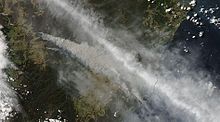2013 NSW Bushfires
| 2013 New South Wales bushfires | |
|---|---|

View of the Blue Mountains fires and the Sydney metropolitan area from NASA's Aqua, using MODIS imagery on 17 October.
|
|
| Location | New South Wales, Australia |
| Statistics | |
| Cost | A$94 million |
| Date(s) | 17 October 2013 – 28 October 2013 |
| Burned area | 118,000 hectares (290,000 acres) |
| Cause |
Multiple causes: |
| Land use | • Residential, • Urban/rural fringe areas, • Farmland, • Forest reserves, • Parts of the Greater Blue Mountains Area World Heritage Site and adjacent national parks |
| Buildings destroyed |
500 |
| Fatalities | 2 |
| Non-fatal injuries | 2 |
Multiple causes:
• Strong winds causing powerline damage
• Military operations and the use of explosive devices
The 2013 New South Wales bushfires were a series of bushfires in Australia across the state of New South Wales primarily starting, or becoming notable, on 13 October 2013; followed by the worst of the fires beginning in the Greater Blue Mountains Area on 16 and 17 October 2013.
High fuel loads, coupled with warm, dry and windy weather, provided dangerous conditions which fuelled the fires. At the peak of the fires, on the morning of 18 October, over 100 fires were burning across the state. The Premier of New South Wales Barry O'Farrell declared a state of emergency on 20 October, empowering firefighters to evict residents and demolish fire-affected buildings.
The fires are the worst in New South Wales since the 1960s. As of 19 October 2013[update], 248 houses and other structures were destroyed across the state. Two fatalities were attributed to the fires. It was estimated that claims will exceed A$94 million.
On 13 October, the Bureau of Meteorology reported that September 2013 was the warmest on record for NSW. The statewide mean daily temperature was 3.4 °C (6.1 °F) above the historical average and 0.9 °C (1.6 °F) above the previous September record (set in 1965). September was the warmest on record for close to 75% of the state and 63 stations, with 100-year stations such as Broken Hill and Wilcannia more than 1 °C (1.8 °F) warmer than their previous record; all other areas of the state recorded temperatures in the warmest 10% of years. Widespread temperatures more than 6 °C (11 °F) above normal were recorded between 22 and 30 September. Warm, dry weather and strong winds during September contributed to significant early-season bushfire activity, particularly along the coastal strip. Fires were particularly prevalent on 10 and 26 September, with two homes destroyed in western Sydney, while several homes in northeast NSW were threatened and the M1 Motorway closed near Taree due to fires on 26 September.
...
Wikipedia
